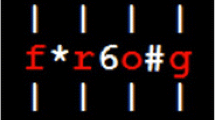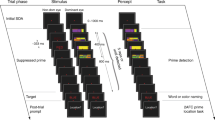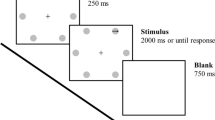Summary
Glaser and Glaser (1989) assume that the processing of colors and pictures is highly similar in that, compared to words, both kinds of stimulis have privileged access to semantic information. This assumption was tested in the present research. In Experiment 1, the season corresponding to the color or to the word of color-word Stroop stimuli had to be named (e.g., green for spring). In Experiment 2, subjects had to name the season corresponding to the picture or the word of a picture-word stimulus (e. g., flower for spring). According to Glaser and Glaser (1989), privileged semantic processing of colors and pictures should be evidenced by a larger interfering power of color and picture distractors than of word distractors. However, the asymmetric pattern of interference was observed only with picture-word stimuli (Experiment 2), but not with color-word stimuli (Experiment 1), suggesting that, unlike pictures, colors do not have privileged access to semantic information. It was also found that word distractors interfered with the semantic processing of pictures, a result that is incompatible with the dominance rule postulated by Glaser and Glaser (1989). From these results, an adapted version of the Glaser and Glaser model is proposed: colors are assumed to have privileged access to a separate color processing system and the pattern of interference depends upon the relative activation strength of the response alternatives activated by the target and the distractor.
Similar content being viewed by others
References
Bovens, N., & Brysbaert, M. (1990). IBM PC/XT/AT and PS/2 Turbo Pascal timing with extended resolution. Behavior Research Methods, Instruments, and Computers, 22, 332–334.
Biggs, T. C., & Marmurek, H. H. C. (1990). Picture and word naming: Is facilitation due to processing overlap? American Journal of Psychology, 103, 81–100.
Cohen, J. D., Dunbar, K., & McClelland, J. L. (1990). On the control of automatic processes: A parallel distributed processing account of the Stroop effect. Psychological Review, 97, 332–361.
De Houwer, J., & d'Ydewalle, G. (in press). Stroop-like interference in sorting for intrinsic colour: A test of the Glaser and Glaser (1989) model. Acta Psychologica.
De Renzi, E., & Spinnler, H. (1967). Impaired performance on colour tasks in patients with hemispheric damage. Cortex, 3, 194–217.
Glaser, W. R. (1992). Picture naming. Cognition, 42, 61–105.
Glaser, W. R., & Düngelhoff, F.-J. (1984). The time course of picture word interference. Journal of Experimental Psychology: Human Perception and Performance, 10, 640–654.
Glaser, W. R., & Glaser, M. O. (1989). Context effects in Stroop-like word and picture processing. Journal of Experimental Psychology: General, 118, 13–42.
Goodglass, H., Klein, B., Carey, P., & Jones, K. (1966). Specific semantic and word categories in aphasia. Cortex, 2, 74–95.
Heathcote, A., Popiel, S. J., & Mewhort, D. J. K. (1991). Analysis of response time distributions: An example using the Stroop task. Psychological Bulletin, 109, 340–347.
Humphreys, G. W., Riddoch, M. J., & Quinlan, P. T. (1988). Cascade processes in picture identification. Cognitive Neuropsychology, 5, 67–103.
La Heij, W. (1988). Lexical context effects in reading and naming. Unpublished doctoral dissertation. University of Leiden, The Netherlands.
MacLeod, C. M. (1991). Half a century of research on the Stroop effect: An integrative review. Psychological Bulletin, 109, 163–203.
O'Leary, M. J., & Barber, P. J. (1993). Interference effects in Stroop and Simon paradigms. Journal of Experimental Psychology: Human Perception and Performance, 19, 830–844.
Ostergaard, A. L., & Davidoff, J. B. (1985). Some effects of color on naming and recognition of objects. Journal of Experimental Psychology: Learning, Memory, and Cognition, 11, 579–587.
Roelofs, A. (1992). A spreading-activation theory of lemma retrieval in speaking. Cognition, 42, 107–142.
Rosinski, R. R. (1977). Picture-word interference is semantically based. Child Development, 48, 643–647.
Seymour, P. H. (1977). Conceptual encoding and locus of the Stroop effect. Quarterly Journal of Experimental Psychology, 29, 245–265.
Smith, M. C., & Magee, L. E. (1980). Tracing the time course of picture-word processing. Journal of Verbal Learning and Verbal Behavior, 23, 3–22.
Snodgrass, J. G. & Vanderwart, M. (1980). A standardized set of 260 pictures: Norms for name agreement, image agreement, familiarity, and visual complexity. Journal of Experimental Psychology: Human Learning and Memory, 6, 174–215.
Stroop, J. R. (1935). Studies of interference in serial verbal reactions. Journal of Experimental Psychology, 18, 643–662.
Virzi, R. A., & Egeth, H. E. (1985). Toward a translational model of Stroop Interference. Memory & Cognition, 13, 304–319.
Warren, C., & Morton, J. (1982). The effects of priming on picture recognition. British Journal of Psychology, 73, 117–129.
Author information
Authors and Affiliations
Corresponding author
Rights and permissions
About this article
Cite this article
De Houwer, J., Fias, W. & d'Ydewalle, G. Comparing color-word and picture-word Stroop-like effects: A test of the Glaser and Glaser (1989) model. Psychol. Res 56, 293–300 (1994). https://doi.org/10.1007/BF00419659
Received:
Accepted:
Issue Date:
DOI: https://doi.org/10.1007/BF00419659




